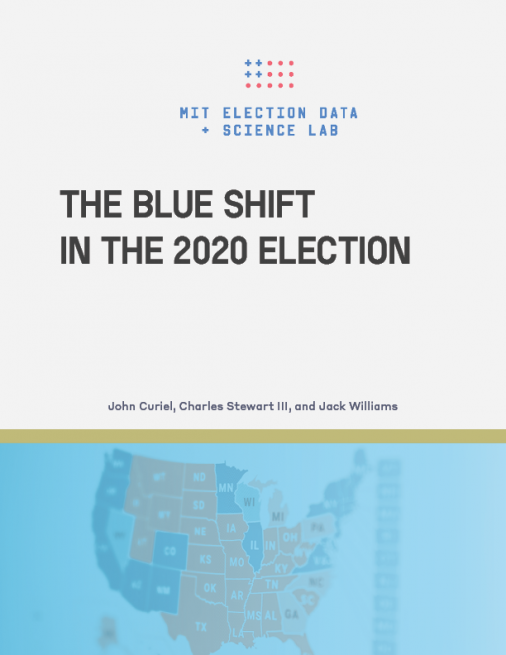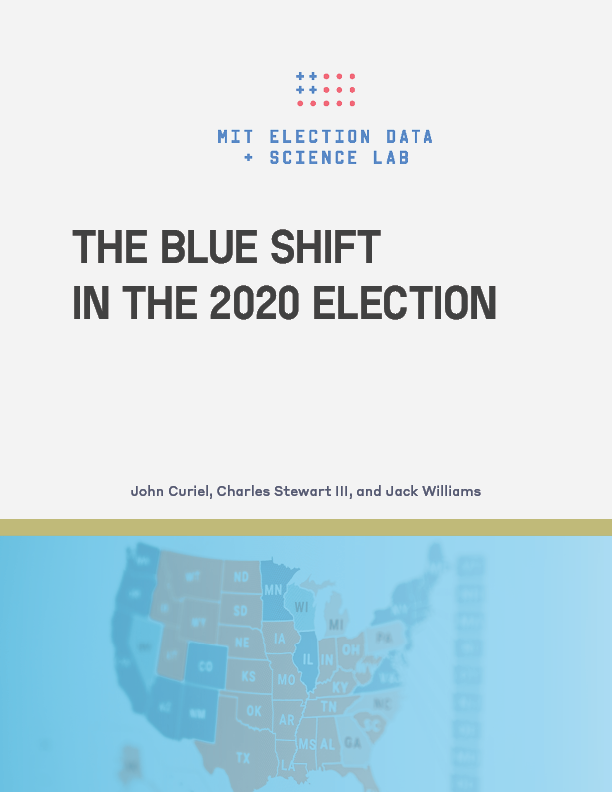The Blue Shift in the 2020 Election
A look at the 2020 election counts, results, and reporting
In the lead-up to the 2020 presidential election, the dynamics of vote counting became a major issue. Public concerns grew about when ballots would be counted, when a candidate’s victory could or would be declared, and when ballots cast by mail, as opposed to in person, would be tabulated.
In the end, election results were reported much more quickly than many had anticipated. As a result, the shifts that occurred were relatively fleeting, failing to outlast election night. In almost every state, the presidential victor was clear within five hours of polls closing. In the few exceptions, the problem was not wild gyrations in reported election results, but the simple fact that the vote count was close.
Our new Report
Here at the MIT Election Data + Science Lab, we wanted to dig into the data, and put the stream of reported vote totals following the election in context. Relying on election results gathered and distributed by the National Election Pool and reported by the New York Times, we found that the overall size of the “overtime vote,” (i.e., votes counted and reported after election night), was comparable in size to the 2016 election, and the degree of the “blue shift” (the disproportionate tendency for overtime votes to trend Democratic) was also comparable to 2016.
We’re excited to release our analysis in a new paper, just published on our website:
Below, we’ve listed a few of our key findings:
Inter-state variation in the pace of reporting votes
- 31 states had reported over 90 percent of their votes within eight hours of polls closing.
- As the number of ballots reported climbed in the states, the vote shares of Biden and Trump tended to converge quickly on the final vote shares. Within eight hours of polls closing, 39 states were within at least two percentage points of where their final results would be.
- At four hours after polls closed, states in the west tended to be showing vote totals more favorable to Biden than the final count, whereas states in the east tended to show results more favorable to Trump than the final count.
- At the forty-eight-hour mark after polls closed, fifteen states were still outside of half a percentage point of where their final two-party vote share would be. Three of these states — Arizona, Pennsylvania, and Nevada — were battleground states.
Declaration of likely winners
- We performed a simplified analysis to show the relationship between the unfolding vote reports and the timing of when the Associated Press projected winners in the states. This analysis ignores uncertainty about final vote totals. That analysis shows that declarations of likely winners generally occurred well before the trailing candidate was “mathematically eliminated,” with the notable exception of North Carolina. The states that were called the latest, compared to the votes that had been reported, were Florida and Ohio — two states that seemed to lean toward Biden in the pre-election polling, but which quickly saw Trump pull out to an insurmountable lead when election results were released.
- Had the networks waited until a sufficient number of states had certified results to guarantee Joe Biden’s victory in the Electoral College to declare a likely winner, they would have waited until December 7, rather than November 7, which is when the networks had declared Biden the likely victor.
The effect of preprocessing restrictions on the pace of vote reporting
- States with prohibitions against preprocessing absentee ballots were slower in reporting election results than states without those prohibitions in the first eight hours after the polls had closed. However, the average differences in reporting paces were not dramatic; several states with preprocessing prohibitions were among the fastest-reporting. Within 24 hours after polls closing, the gap in reporting speed between the two groups of states had disappeared.
The correlation between size, partisanship, and mail-ballot volume with pace of reporting
- In most states, votes were reported at a faster rate in counties that were smaller and more Republican, although there were exceptions.
- The correlation between the fraction of votes cast by mail in a county and the speed with which votes were reported was positive in about as many states as it was negative. In other words, counties with more absentee ballots were slower to report votes in only about half the states.
Case Study: Variability of reporting pace within precincts
- Analyzing precincts in Georgia, we find that the absentee portion of vote returns tended to come in multiple waves over a twenty-hour period, early-in-person returns were reported over a one-hour period, and Election Day returns were reports almost instantaneously after polls closed.
Read the full report, or browse our other reports and working papers, by visiting our research portal here:


